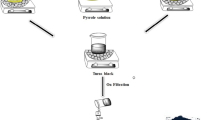Abstract
Thermal behavior of 2,4,6-tris(4-(1H-pyrrol-1-yl)phenoxy)-1,3,5-triazine monomer, polypyrrole, and their star shaped copolymer, were investigated using TG and DTA methods. It was found that Tria melts at 517 K and after than it starts to decompose. Decomposition proceeded in two stages which were corresponding to removal of branched groups and remaining core structure degradation, respectively. Polypyrrole and copolymer showed similar thermal behaviors. These compounds decomposed in three stages which are removal of solvent, removal of dopant anion and rest of structure decomposition. The calculation of activation energies of all reactions were realized using model-free (KAS and FWO) methods. The graphs were prepared which show the alteration of activation energy with decomposition ratio. Thermal analysis results showed that dopant anion and solvent removal activation energy values for copolymer are lower than polypyrrole. Star shaped loose-packed novel structure greatly facilitates solvent and dopant anion removal from copolymer. It can be concluded also that thermal analysis can be used as predict package structure of conducting polymers.






Similar content being viewed by others
References
Chiang CK, Fincher CR Jr, Park YW, Heeger AJ, Shirakawa H, Louis EJ, Gau SC, MacDiarmid AG. Electrical conductivity in doped polyacetylene. Phys Rev Lett. 1977;39:1098–101.
Skotheim TA, Elsenbaumer RL, Reynolds J. Handbook of conducting polymers. 3rd ed. New York: Marcel Dekker; 2007.
Ak M, Toppare L. Synthesis of star shaped pyrrole and thiophene functionalized monomers and optoelectrochemical properties of corresponding copolymers. Mater Chem Phys. 2009;114:789–94.
Belot C, Filiatre C, Guyard L, Foissy A, Knorr M. Electrosynthesis of structured derivated polythiophenes: application to electrodeposition of latex particles on these substrates. Electrochem Commun. 2005;7:1439–44.
Omastova M, Kosina S, Pionteck J, Janke A, Pavlinec J. Electrical properties and stability of polypyrrole containing conducting polymer composites. Synth Met. 1996;81:49–57.
Cabala R, Skarda J, Potje-Kamloth K. Spectroscopic investigation thermal treatment of doped polypyrrole. Phys Chem Chem Phys. 2002;2:3283–91.
Jakab E, Mészáros E, Omastová M. Thermal decomposition of polypyrroles. J Therm Anal Calorim. 2007;88:515–21.
Hosseini SH, Entezami AA. Polypyrrole based gas sensors by mass and conductivity measurement. Iran Polym J. 1999;8:205–13.
Ozawa T. Kinetic analysis of derivative curves in thermal analysis. J Thermal Anal. 1970;2:301.
Çılgı GK, Cetişli H. Thermal decomposition kinetics of aluminum sulfate hydrate. J Therm Anal Calorim. 2009;98:855–61.
Boonchom B. Kinetic and thermodynamic studies of MgHPO4·3H2O by non-isotehermal decomposition data. J Therm Anal Calorim. 2009;98:863–71.
Rejitha KS, Mathew S. Thermoanalytical investigations of tris(ethylenediamine)nickel(II) oxalate and sulphate complexes: TG–MS and TR–XRD studies. J Therm Anal Calorim. 2010;102:931–9.
Ocakoğlu K, Emen FM. Thermal analysis of cis-(dithiocyanato)(1,10-phenanthroline-5,6-dione)(4,4′-dicarboxy-2,2′-bipyridyl)ruthenium(II) photosensitizer. J Therm Anal Calorim. 2011;104:1017–22.
Cetişli H, Koyundereli Çılgı G, Donat R. Thermal and kinetic analysis of uranium salts Part 1. Uranium (VI) oxalate hydrates. J Therm Anal Calorim. 2011. doi:10.1007/s10973-011-1826-9.
Ak M, Sulak Ak M, Toppare L. Electrochemical properties of a new star-shaped pyrrole monomer and its electrochromic applications. Macromol Chem Phys. 2006;207:1351–8.
Skaarup S, West K, Gunaratne LMWK, Vidanapathirana KP, Careem MA. Determination of ionic carriers in polypyrrole. Solid State Ionic. 2000;136–137:577–82.
Ak M, Gacal B, Kiskan B, Yagci Y, Toppare L. Enhancing electrochromic properties of polypyrrole by silsesquioxane nanocages. Polymer. 2008;49:2202–10.
Xiong S, Xiao Y, Ma J, Zhang L, Lu X. Enhancement of electrochromic contrast by tethering conjugated polymer chains onto polyhedral oligomeric silsesquioxane nanocages. Macromol Rapid Commun. 2007;28:281–5.
Author information
Authors and Affiliations
Corresponding author
Rights and permissions
About this article
Cite this article
Ak, M., Çılgı, G.K., Kuru, F.D. et al. Thermal decomposition kinetics of polypyrrole and its star shaped copolymer. J Therm Anal Calorim 111, 1627–1632 (2013). https://doi.org/10.1007/s10973-012-2351-1
Published:
Issue Date:
DOI: https://doi.org/10.1007/s10973-012-2351-1




